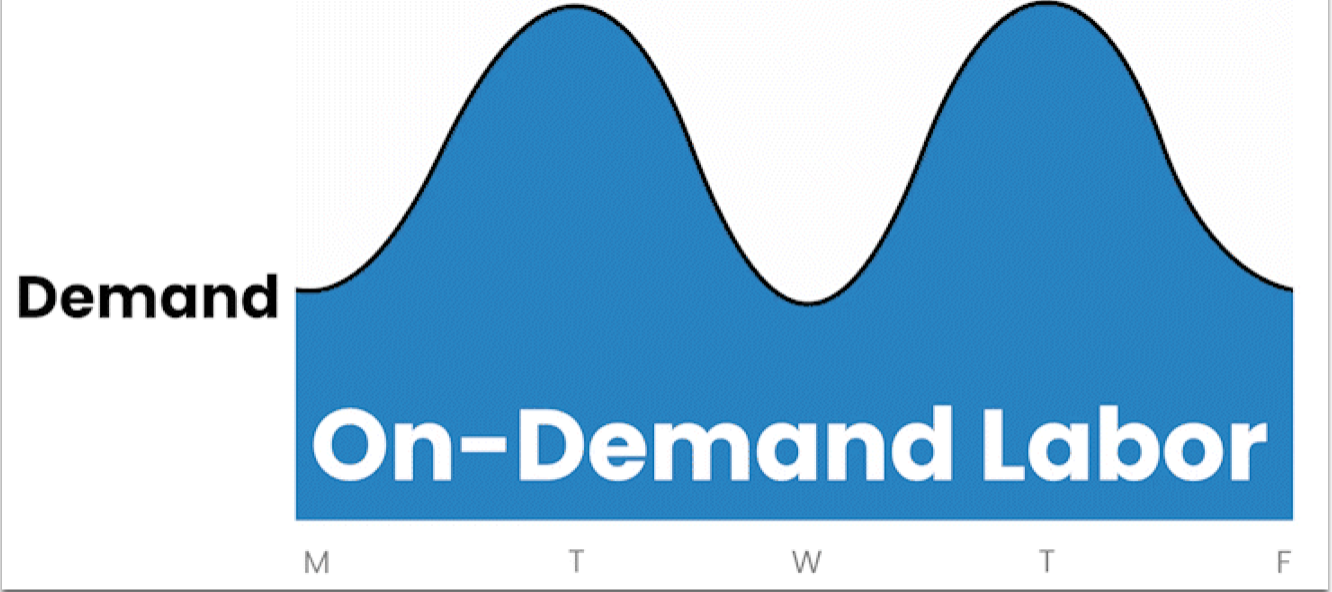Down Cycle Agility: Why It Matters More Than Ever in Today’s Economic Environment and How Veryable Enables It
Manufacturing, logistics, and distribution companies are operating in one of the most uncertain environments in recent memory. Indicators across the economy are beginning to converge around a single theme: demand is becoming more volatile, and the economy appears to be moving toward a deflationary phase driven by consumer strain, shifting cost structures, and cooling output.
Recent analysis, including research published by the San Francisco Fed, reinforces several emerging signals. Tariffs, which many assume are inflationary, have historically behaved more like demand shocks than cost shocks. That means instead of pushing prices higher, tariffs often slow demand and help cool inflation. At the same time, companies are seeing softer freight activity, slower manufacturing output, rising consumer leverage, and more uneven household spending.
None of these signals are definitive on their own, but together they suggest that many of the impacts of a demand slowdown are already present. In this environment, operational agility becomes a strategic necessity rather than a nice-to-have. Companies that can quickly rebalance labor, cost, and output will preserve margins and avoid the disruption that typically accompanies a sudden drop in volume.
This is where down cycle agility becomes essential, and why on-demand labor has become a key advantage for companies that need the ability to scale up and down without damaging their cost structure or their teams.
What Is Down Cycle Agility?
Down cycle agility is the ability to adjust quickly and precisely when demand decreases. It means aligning your labor capacity and cost structure to actual volume before the slowdown turns into a margin problem.
In practical terms, down cycle agility means being able to:
- Scale labor down without layoffs by reducing only your flexible capacity, not your core team
- Maintain continuity and service levels because you’re not distracted by constant reassignments, morale issues, or reactive cuts
- Shift workload or labor needs across sites to match where demand still exists
- Absorb internal disruptions like maintenance downtime or quality events without stacking unnecessary labor cost on top of lost output
Companies that navigate downturns most effectively are the ones that remove labor rigidity from their cost structure. A fixed labor model makes this difficult because the organization carries the full cost of a workforce built for peak demand even when volume softens—leading to margin erosion long before revenue recovers.
Why Down Cycle Agility Matters More Than Ever
Current economic conditions amplify the need for agility and responsiveness. The following signals are shaping the operational landscape:
1. Demand-Based Deflation Signals Are Increasing
Consumer pressure continues to build through higher leverage, elevated essential costs, and more selective discretionary spending. Softening demand can show up first in order reductions, extended buying cycles, or smaller replenishment patterns. Companies that cannot match labor to this reality see margin degradation long before cuts become unavoidable.
2. Freight and Manufacturing Indicators Are Flat or Declining
Outbound tender volumes, manufacturing PMI readings, and supplier delivery times have shown persistent weakness. These indicators typically lead labor needs by several weeks. When output slows, companies that operate with fixed labor cannot rebalance quickly enough.
3. Asset Markets Are High While Production Remains Uneven
When financial markets remain strong but real output stagnates, margin pressure becomes a more immediate operational concern. Leaders cannot rely on top-line growth to absorb inefficiencies.
4. Tariff Effects Are Operating Like Demand Shocks
The SF Fed’s findings highlight that tariff shocks historically correlate with softer output and higher unemployment, not higher inflation. If tariffs continue to influence demand rather than cost, companies may experience more volume volatility rather than predictable cost increases.
5. Domestic Production Will Play a Larger Role in the Next Cycle
As global volatility reshapes supply chains, domestic production capacity becomes strategically important. Companies that can add or subtract labor precisely will win the opportunities that shift back onshore.
These conditions do not guarantee a downturn, but they make one more likely and more important to prepare for.
Why Fixed Labor Models Struggle in Down Cycles
Fixed labor models work only when demand is stable. The moment demand softens or surges, they become a liability. A fixed headcount forces companies to make labor decisions based on averages, forecasts, and hope — not on the actual volume moving through the operation.
When demand drops, the cost structure does not drop with it. That mismatch creates a series of cascading challenges:
Underutilization and margin erosion
You’re paying for labor capacity you don’t need, which directly compresses margins and shrinks the cash cushion needed to navigate volatility.
Idle time disguised as “stability”
Workers stay on payroll even when there isn’t enough work to fill a full shift, but the cost remains the same. Underutilization quietly compounds into a major financial drag.
Slow reaction times when demand shifts
Fixed labor means you cannot scale down quickly without painful cuts, and you cannot scale back up quickly without rehiring — a process that adds weeks of delay at the worst possible moment.
Increased strain on full-time teams
Leaders try to “make the best of it” by reassigning people, but this often reduces productivity, increases churn, and pulls skilled workers away from high-value tasks just to keep them busy.
Pressure to cut the wrong things
When payroll becomes the only flexible lever, layoffs become the default reaction. This damages long-term capacity, capability, and culture — and makes recovery slower and more expensive.
Temporary staffing agencies do not fix this problem.
They still operate with fixed blocks of labor, with workers who are assigned to you regardless of performance history, reliability, or fit. You get capacity in chunks, not in the precise increments required to match real demand. And when volume falls, you still carry the cost of minimum-hour requirements, contracts, or idle temp workers onsite.
This is why fixed labor models consistently underperform in down cycles. And this is exactly where Veryable’s on-demand labor model creates a structural advantage.
How On-Demand Labor Enables Down Cycle Agility
Veryable’s on-demand labor model gives companies the ability to scale labor capacity up or down in real time by building trained pool of on-demand Operators who are invited only when their work is required. Instead of carrying excess full-time headcount into a slowdown, companies maintain a smaller core team and flex around it as needed with their on-demand labor pool.
In a deflationary or demand-softening environment, this creates several critical advantages:
1. Scale Down Instantly When Demand Softens
When orders slow, companies simply stop inviting on-demand Operators. There are no layoffs, no severance costs, and no disruption to the core workforce. The operation returns to its baseline headcount instantly. This protects margins during early demand shifts and eliminates the painful “overstaffed lag” where fixed labor costs continue climbing while volume falls.
2. Level Load Across Multiple Facilities
Many companies distribute work across regional networks. When demand shifts from one site to another, fixed labor creates:
- travel and lodging expenses
- uneven utilization between sites
- overtime at one facility and idle time at another
- leadership distraction as teams are reassigned
With on-demand labor, each facility maintains its own bench of trained Operators. If workload shifts from Memphis to Nashville, the Nashville facility can bring in on-demand Operators immediately, without moving full-time employees or absorbing unnecessary labor costs.
3. Avoid Overcorrecting During Short-Term Dips
In fixed labor environments, a sudden slowdown forces a binary choice:
- absorb excess labor and erode margin, or
- cut labor and risk being understaffed if demand snaps back
On-demand labor removes this tension. Companies can pull back capacity the moment demand slows, then re-expand the moment it returns — without rehiring cycles, training lag, or operational disruption. This prevents both overreaction to temporary dips and underreaction to unexpected rebounds.
4. Maintain Output and Service Levels With a Smaller Core Team
Down cycles require tighter labor-to-output alignment. Veryable enables leaders to adjust capacity in increments as precise as a single shift, allowing companies to:
- match labor to actual daily volume
- maintain service levels without overspending
- avoid burnout of full-time teams
- protect flow when internal disruptions occur (maintenance, quality issues, equipment outages)
This improves operational resilience in environments where demand is both softer and more variable.
5. Build a Workforce Model That Moves With the Market
Down cycles don’t punish companies equally. The companies that outperform are those that can remove labor rigidity from their cost structure.
With an on-demand labor pool in place, companies can:
- reduce labor spend the moment volume declines
- increase capacity as soon as opportunity appears
- respond to market shocks without destabilizing full-time teams
- absorb volatility with far less financial exposure
The result is a labor system that moves with the market instead of against it — and gives companies the control they need to protect margins while maintaining operational readiness.
Real Example: A Midwestern Industrial Components Company Maintains Margin When Tariffs Slow Demand
A Midwestern company that assembles industrial components for HVAC manufacturers entered the year expecting steady volume. Then, in March, several of their customers were hit by a tariff adjustment on imported subcomponents. Instead of passing costs through immediately, those customers paused new orders to rebalance inventory and evaluate how the tariff changes would affect pricing and sourcing.
Within three weeks, the assembly company saw order volume drop 18%.
Historically, this would have created immediate margin pressure, as even small demand dips can cause excess labor capacity, idle time, and underutilized production lines. But because the company had built a labor pool through Veryable, they responded in real time:
- They paused invitations to on-demand operators as soon as the slowdown became visible in the order schedule. Full-time employees stayed fully utilized, and the company avoided the need to cut hours or reshuffle roles.
- They kept throughput stable by reassigning their skilled employees to the most value-critical areas, while temporarily reducing support tasks normally handled by on-demand operators.
- They protected margins immediately because their labor costs contracted in direct proportion to the volume decline
- They preserved flexibility for a rebound. When a major customer resumed ordering in April, the company was able to scale back up within 48 hours by inviting previously trained operators from their labor pool.
Instead of absorbing several weeks of overstaffing and inefficiency, they matched labor to demand within days, maintained output commitments, and avoided the margin erosion that typically accompanies a sudden demand dip.
As their operations director put it:
“The Veryable labor pool let us tighten costs the moment demand softened and then ramp right back up the moment it started coming back.”
The Bottom Line
As the economy moves toward softer demand, rising consumer pressure, and greater volatility, companies can’t afford a labor model that stays fixed while their workload shrinks or shifts unpredictably. On-demand labor gives companies a strategic advantage by reducing the cost of variability and allowing them to right-size capacity in real time.
With an on-demand labor pool, companies can scale down immediately when volume falls, protect margins, safeguard full-time teams, and avoid the financial drag of carrying excess labor. Then when demand returns, they can scale back up just as quickly, without taking on additional fixed labor risk.
In any period of economic uncertainty, the companies that build down cycle agility will outperform those that rely on rigid, forecast-driven staffing models. On-demand labor enables operations leaders to match labor to real workload, absorb downturns more effectively, and move faster when conditions improve.
Previous Posts
What Is an On-Demand Labor Pool? A Beginner’s Guide
The Future of Manufacturing and Logistics
Create a free business profile today to explore our platform.






